|
|
Post by stlkigers on May 3, 2010 20:43:20 GMT -5
Love this thread....LOVE IT!!!!!!!!!!!!Thanks Sbutter for putting out the photos and video!
Angela
|
|
|
|
Post by Michelle Clarke on May 3, 2010 22:08:51 GMT -5
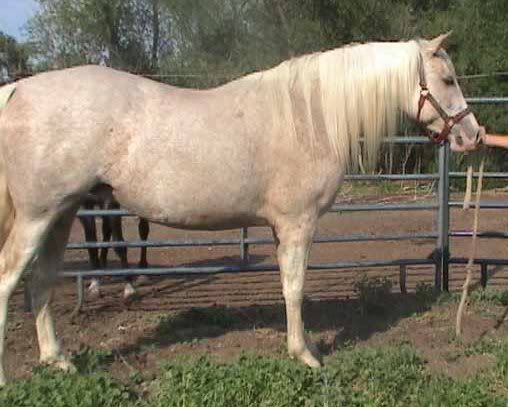 This is a four year old Azteca D mare...meaning she is half quarter horse and half Andalusian or Lusitano (my guess w/her conformation is Andy). I wish her backend was not cut off, but you can get a good idea of her back and topline. Though she is four and still has some growing to do, her hip is alot higher than her wither - don't belive at this extreme she will end up built up hill. One of the things that the real breeders of Aztecas do is use Quarter Horses that have Iberian conformation and being downhill is a fault and they simply don't breed it. It seems as if maybe on the Quarter horse side there may have been a good amount of thoroughbred too. She also dips a little low behind those withers and has what I call a banana back, though not extreme. A flat paneled saddle would pinch her shoulders and loins and bridge over her back; not to mention with the downhill build throwing that saddle foward onto the shoulders. The thing I love about this mare is that her front legs are set well underneath herself and not too far foward as you see in alot of different breeds, including spanish type horses. Another thing to visualize when you are looking for a saddle type horse is to imagine where the girth of the saddle needs to sit...right behind the front legs. Now let your eye go upwards to the topline and imagine where the saddle would have to sit over her wither in order for the girth to sit where it wants too...this mare is not so bad, as the saddle would not have to be too far forward to sit properly. Many times the front legs are set so far forward that the saddle would have to sit halfway up the neck in order for the girth to lay in the proper place. Even if you set the saddle back, with the girth further back behind the elbow, most times the saddle will slip forward as you ride or warmup. If you tighten it enough to where it doesn't (and if your horse can still breath), you'll find yourself behind the motion of the horse as they move because you are not sitting over the horses' center of gravity (starting in elementary training right behind the withers). Another thing to look at is her topline compared to the belly line of the horse. The topline should always be longer when viewed and the underside of the horse should be shorter. This mare has a longer bottom line than topline which makes it very easy for her to drop her back, put her head up in the air and let her hindend fall out behind - just as if you got on all fours and arched your back. You'd be working against her natural build to get her trained close to correct so she does not break down over the years. Looks like she's bred, making more of the same I would guess. |
|
|
|
Post by Michelle Clarke on May 3, 2010 22:19:45 GMT -5
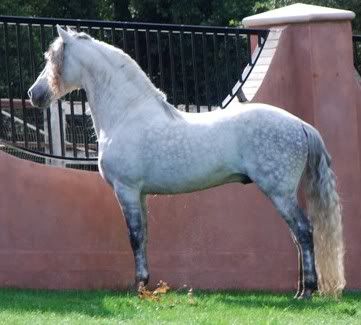 This guy is interesting...Andalusian, not sure how old he is; length of forelock makes me think he is mature and done growing. Another example of how the topline seems shorter than the underside. He is built uphilll and in my opinion, his back is too short and he has a lack of loin. Most likely hard to get round correctly and probably good at locking his back and not working through. He is a perfect example of the front leg set way to forward. I wish we could see his feet because I bet he has no heel and grows lot of toe because he has to let those legs lean backwards to compensate for carrying more weight on the front; lots of added pressure on those pasterns too. Just imagine on him where the girth needs to be in conjunction to the saddle up top...yikes! If I had to put this horse in a job, I would say driving would be your best bet or some might even do Saddle Seat with him... |
|
|
|
Post by Michelle Clarke on May 3, 2010 22:33:39 GMT -5
 Lusitano mare, six years old, mostly finished growing. Not the best shot to view from the side, but you can see she is uphill with a nice flat, level back. Her back flows nicely from her neck and into her hip. Her front legs look well set underneath her and it appears the saddle would sit normally without interferring with the shoulders too much. The only thing I don't like is that they have her standing with her head too high and not a little more foward showing off her neck, which would be more natural. The neat thing about that is, though, is even with her head up in the air, it has not dropped her back! |
|
|
|
Post by sbutter on May 4, 2010 14:47:53 GMT -5
|
|
|
|
Post by Michelle Clarke on May 4, 2010 19:00:11 GMT -5
Thanks for posting the videos of the inspection...keep in mind that even though this is a "spanish type" horse, it is also a gaited horse and built very different than a trotting horse. This breed tends to have a longer back and the steep angles of the shoulder and hip for quickness in gaiting. The angles need to be sharp from the shoulder to the elbow because of the lift needed for the quick up and down movement.
The judge seems as if he is being kind when he is asked alot of questions, especially when speaking of the back and how it needs improvement - when someone asks about building it up with riding, he says "yes"; though it will build muscle, it will not change the dip of the spinal column that the gelding has.
In the riding part (which I did not watch a whole lot of...) I never even see the horse gaiting. I have seen very nice horses in this breed and there is a reason this horse is a gelding...
|
|
|
|
Post by barbhorses on May 4, 2010 19:45:51 GMT -5
I would be curious as to the opinions of this horse. Yes, he is obese (not my horse), but I like him due to his old style Spanish type accompanied with plenty of spirit and fearlessness. Truly, a horse that when you witness him you can really understand how the Spanish conquered the Americas! Obviously I admire him, but I hope by now that you all know that I can shell it out and take it back.  So, what do you think? I am sorry about the poor quality of the photos. It came off of a video. 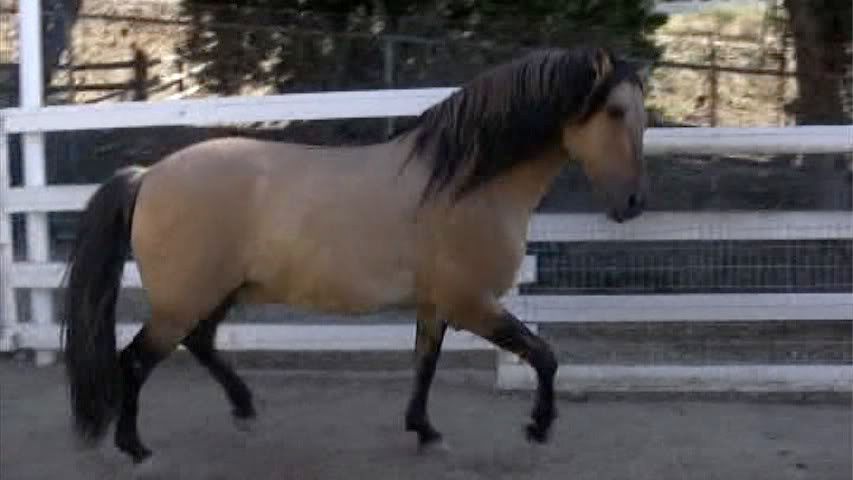  |
|
|
|
Post by kigermustang1 on May 4, 2010 20:33:46 GMT -5
For what its worth, I prefer this old style. That is one of the traits that drew me to Shasta, the mare I am leasing. I love a good solid substance with balance and movement. Over weight or not I really like the look of him at first glance.
The only question I have is that it appears in the photo that his neck comes out from deep in his chest. How, if at all would that effect flexability and balance when asked to move out or when asked to collect?
I am not into pencil necked horses but I think a bit more refinement in the lower neck/ chest area might help with movement. Especially if he were to be trained for reining or cutting. Your comments and feedback would be most appreciated.
|
|
|
|
Post by barbhorses on May 4, 2010 22:39:33 GMT -5
Surprisingly, he easily is able to get into a levade (although very brief) and repeatedly rears up in a more collected form despite his depth of neck and his obesity. He is a very playful and engaging stallion that I have only been able to get to shy slightly away from a box of rattling Nerds (the candy that sounds like a snake). I am not certain about his movement due to the fact that his pen is not all that large to move in and also the fact that he is really overweight. I would love to buy him and use him. If only I had the land! I would also have him trained for AI. *dreaming* 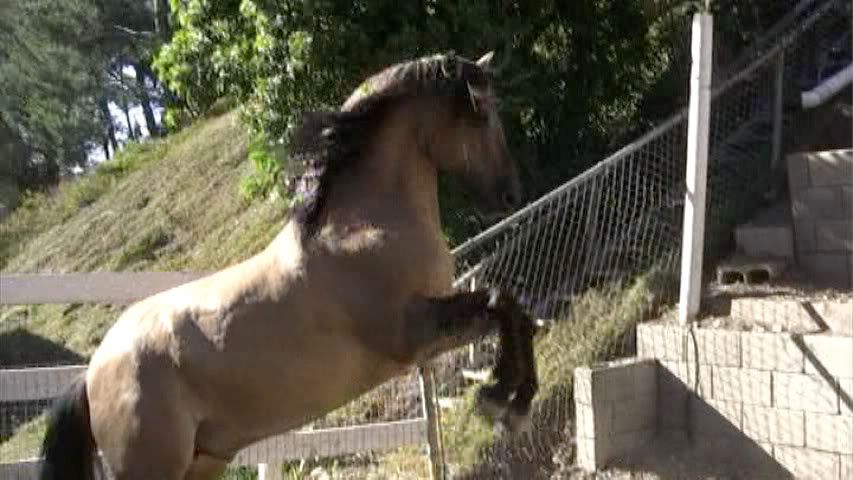 His name is Mestene's Pueblo [Sulphur's Chance x Mestene (The Blue Stallion x Sulphur's Molly)]. He is a 1996 stallion that was bred by Ron Roubidoux. |
|
|
|
Post by Michelle Clarke on May 5, 2010 7:48:37 GMT -5
He's a cute horse, though your right, obese! When I let Desi get fat, he looks squatty, like he had shorter legs than he really did, so it is very hard to tell true shape when they are so heavy. That's the way this guy looks, like his legs are too short for his body type.
Many people take the big fat round shape for the Baroque type of horse...they only appear to be Baroque because they are so fat. Baroque horses are round looking because of the shape of their bodies, the way they carry themselves and the way the legs move. They have hard angles in the hip/shoulder bones and their legs move very much up and down while coming forward while they are high in the air - kind of like your legs when you bicycle.
They will also fit into a square if you eye them from front to back and bottom of feet to wither/croup. This guy would fit into a rectangle, as he has appears to have a longer body style. Hard to tell from the picts, but this horse does not have alot of lift; the angle from the point of his shoulder to his elbow is not steep enough, plus the angle from the point of the hip to the stifle. These angles need to be tight and "unfold" as they move. Now, I am sure you can capture a picture of two of a horse like this really high stepping (like a Arab at the floating trot), but this is not something he can sustain for any length of time, especially with a rider up - he's simply no built for it.
Horses that fit more into the rectangle shape have more reach and can develop nice extention. This is the more modern Sport Horse build. Interestingly enough, when I measure out the horses in our program that I like, they are rectangles, but up ways (taller than longer), which I've found many of the Kigers are that way plus alot of Lusitanos that I've studied...
As far as the levade, it is a highly collected move where the horse rocks back on the hocks and the body is no more than a 45 degree angle from the ground. The body is elevated right over the back legs with the feet being way up under the belly and the front legs very controlled. It is a an extreme movement and one that takes years of correct training. This guy is having a good time rearing up by throwing the front end of his body in the air by pushing off his front feet. I can tell this because the angles in his hind legs are very open, not tight and he simply does not have the strength in his hindend to do that in his state of fitness. Not saying he's not a cute horse...!! He is indeed.
Karen, you are right about his neck being set low and it is pretty thick at the bottom, not clean looking. You can also tell by the angle of this shoulder that his natural neck set is actually lower than he holds it when he is showing off and moving tight using his flexor muscles instead of his extenders. His poll would be a good four inches lower if he were ridden correctly and allowed to move forward instead of being forced to appear "collected".
He does have a nice topline but another thing to notice if we are thinking of an Iberian type horse is that the length of his head is rather short - like a cob, not long and thin. His throatlatch is very thick and course, which would agian, make it hard to sustain any correct flexion at that area for proper riding; it would not only hinder his breathing but he would find it difficult to to truly get round, except at elementary stages of training where the head and neck are lower and more stretched out.
|
|
|
|
Post by Michelle Clarke on May 5, 2010 7:54:38 GMT -5
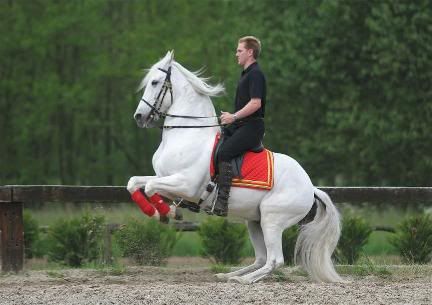 This is a good idea of what a levade really is...if you look up picts on the net, you'll see all kinds of interpretations, but notice how the hocks are almost on the ground and the neck has to be brought in and up in order to keep the balance back. Sorry, my Classical training makes me a bit picky on what people casually call very difficult movements that take years of training!! |
|
|
|
Post by barbhorses on May 5, 2010 11:45:56 GMT -5
Thanks for the review, he actually is not long at all in person. He would fit into a square. If the angle of the humerus is more open (greater than 90 degrees) then the horse will also still be able to lift their legs with some knee action despite the fact that the shoulder is well laid back. Pueblo has a nice short back, neck comes out where it is suppose to, hip is round in profile, pin bone doesn't stick out,and tail set low, head is not wedge shaped (which is not old Iberian, but modern) although his head looks more wedge shaped from these pics for some reason.
You also must realize is that old Iberian is not baroque. That period began after the old Iberian horses were imported to the New World. The modern Spanish horses has a lot of outside blood in them. They were bred for show so that the king could ride his elegant horse on the day of victory (or w/e). You must realize that having excessive high knee action would be a waste for the Iberian warhorse in energy. Pueblo has some knee action (like any Sulphur does), but it is not in excess as he is old Iberian and not modern. His ancestors were from CA and bred for war as well as taking care of a ranch (or mission). His ancestors were imported before Charles V started to cross the old Iberian horse with horses from the low lands (the original Friesian aka warmblood).
The angle of his back hoof goes straight up to his knee so that tells us he can use his hindquarters well.
I wish he wasn't so fat so he could be viewed better and obviously my pictures need to be better. Funny how pics can play tricks on you! This has been very interesting!
|
|
|
|
Post by barbhorses on May 5, 2010 12:03:53 GMT -5
I was trying to find a picture of Pueblo where he was holding his neck when he is relaxed. Hard as he likes to be a "pocket pony" all the time! In this shot he just lifted his head from sniffing the ground and put it in a relaxed position. He is walking and about to come toward me again. The picture quality is better, but the angle is bad.... I should be seeing him again in about two weeks or so. Maybe I can get better photos of him. Although I am sure he is still just as fat. 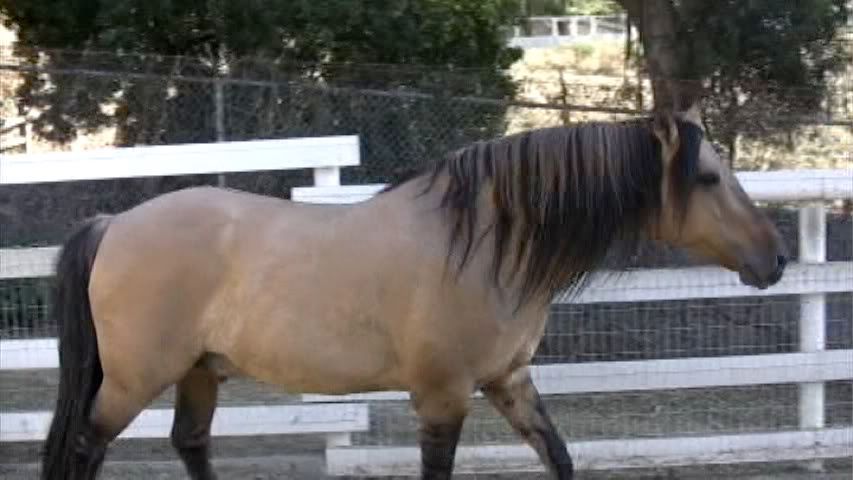 Right on Michelle! He does throw himself up into the air with his front end. I remember him when he wasn't so fat (but rather angry because he was all by himself. At least now he has a goat friend to keep him company) and he would be able to round out his back and was really powerful looking when he would rear. He was able to move much better as well. I suppose asking him for nice movement at this stage would be the same as asking a 300 pound person to move out as well as someone that was not obese. Not gonna happen! |
|
|
|
Post by Michelle Clarke on May 5, 2010 12:19:22 GMT -5
Yes, that is sure a more natural angle for his neck. I understand that old world iberian is not the same as Baroque...I was just pointing out the factors that people consider Baroque. I would be very interested in where you have your information on what the "old style iberian" horse looked like, since there are none around anymore.
From The Royal Horse of Europe, by Sylvia Loch (who can be considered an expert on the Iberian type horse...):
The Iberian Factor:
-a slightly convex profile of the head
-large, generous eyes
-a long powerful neck, deep at the base and set at a rather wide angle to the shoulder
-high withers
-a short-coupled body with powerful loins, the back almost appearing rounded
-hind legs positioned well under the body axis, producing excellent hock action and thrusting forward impulsion
-small, round, high hooves
-a tempermament of exceptional courage, willingness, and kindness
I don't want to get off topic right now of mainly discussing the back, but one of the last things we can talk about is the fact that the horse should be a good representation of the breed, whatever that looks like.
I'm not sure what your point is about the angle of the hoof meaning that the horse can get underneath himself...I can't say that would be any deciding factor, due to the fact there is so much more to consider (such as the hip angles, loin and flexion of the sacrum), not to mention how a farrier can influence that tremendously.
The last picture that was posted of the stallion is a much nicer one and probably more reprentative of what he really looks like - his head does look better.
|
|
|
|
Post by barbhorses on May 5, 2010 12:32:15 GMT -5
I do need to read her book. I got put off when she stated that the Sorraia is an ancient horse... We know that the Sorraia has no history to support that claim so it put me off from reading her book as the second question would be: what else did she put in there that is just off of guess work that has no facts to support it?
Yes, the back almost appears round due to the fact that the lumbar round up. I have a picture of a Sulphur somewhere that is in poor condition and you can unfortunately see the lumbar rounding up into the sacrum. This is important for the overall picture of the Spanish horse as it gives the appearance of roundness at least through the back. Most Spanish type Sulphurs have a rounded lumbar. Pueblo does, but his fat on his ilium is making it look otherwise... poor horse. He also has fat on his back where you could pour water on him and it would sit in his "ravine"... Although it does disappear over his croup so he does not have an "apple butt" like a QH when viewed from behind. Here is my description for the hip (thought it fitting being that we are talking about roundness through the back):
There is not one set type such as the horse MUST have rafter hips. The ideal type of a Spanish hip would be this: the pin bone should give the appearance of flowing evenly with the base of the tail, the croup should give an appearance of roundness ( you will read on different boards as this being a round sacrum), there shouldn't be any excessive muscling over the wing of the ilium or the points of the ilium. One of the points of Spanish conformation is to have smooth muscling, not bunchy or excessive muscling. With this, the points of the ilium shouldn't be high where it gives a boxy appearance when viewing the horse from behind. There should also not be a muscle line that comes off of the pin bone (the semitendinosus). You often see this muscle line on say a QH or TB. The hips should also not be broad when viewed from behind. The Spanish horse is a light horse breed, therefore, the width of the hips should not be set wide like you would see on say a draft horse and also on a QH. There should also be a smooth transition that goes from the wing of the ilium into the back. There shouldn't be any sharp dips to the back. The tail should also be set on low. High set tails are a characteristic of Arabian horses, and so therefore should be avoided in breeding Spanish horses. The bone on a Spanish horse should also not be dense, nor should it be overly refined. You should also see that the ilium and the stifle should appear directly under or above the other depending on if you are talking about the stifle or ilium.
|
|